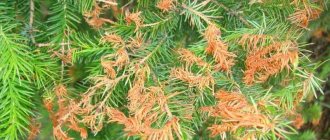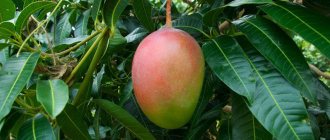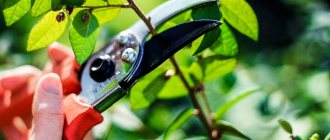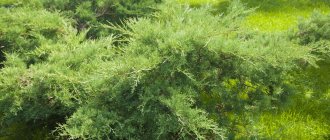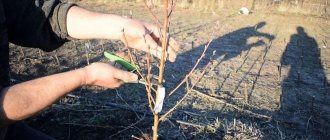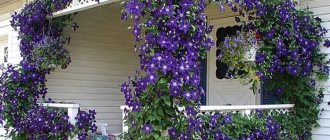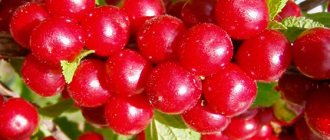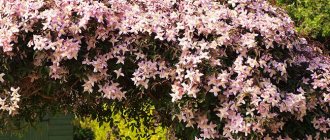Viburnum (lat. Viburnum) belongs to the genus of woody flowering plants of the Adoxaceae family, of which there are more than 160 species. Representatives of this genus are distributed in the temperate zone of the northern hemisphere, as well as in the Andes, the Antilles and Madagascar. The plant received the Slavic word “viburnum” presumably because of its red, seemingly red-hot berries. In Slavic culture, there are many legends, tales, sayings and proverbs about viburnum. In the middle zone you can most often find the species viburnum (Viburnum opulus), but for some time now this plant has appeared in our gardens.
Viburnum bushes - description
Viburnum is a deciduous shrub or small tree. Viburnum leaves are opposite, sometimes whorled, deciduous, simple, lobed, palmately lobed or entire, serrated or entire, petiolate. The apical simple or complex umbellate or umbellate-corymbose inflorescences consist of pink or white flowers. Flowering viburnum begins in late May or early June. The fruit is usually an edible drupe of red or blue-black color. The lifespan of viburnum is on average 50-60 years.
Today, viburnum is gaining popularity among amateur gardeners and is grown in home gardens along with such fruit trees as apple, pear, plum, cherry and sweet cherry. We offer you a detailed story about how to plant viburnum in your garden, how to care for viburnum from the moment of planting until the end of its life cycle, how to propagate viburnum, how to feed viburnum to ensure a stable harvest of its most valuable berries, how to prune viburnum to prolong its lifespan - we have collected and systematized all this information in our article so that it is easy and convenient for you to use it.
How to grow viburnum "Buldenezh": planting and care in open ground
The variety “Buldenezh” (from the French “snowball, ball”) deserves special attention. This is a very decorative bush, which is famous for its attractive, rich flowering. The description of the viburnum variety "Buldenezh" fully corresponds to its name: light flowers collected in large umbrellas with a diameter of 15-20 cm really look incredibly similar to snow globes.
How to plant viburnum “Buldenezh”, look at the photo - they show the key points of the procedure:
It is necessary to provide viburnum "Buldenezh" with care after planting - look at the photo for what it should be like:
Planting viburnum
When to plant viburnum.
Planting and caring for viburnum does not involve any difficulties. Viburnum grows well on neutral and slightly acidic soils (pH 5.5-6.5), but peat, podzolic and sandy soils are not suitable for it. The depth of groundwater in the area where viburnum grows is desirable to be at least 1 m. In order for your viburnum to grow for a long time and be healthy, create conditions for it that are close to natural.
Viburnum loves good light, but grows best in partial shade. Some experts even claim that viburnum grown in shady places is less susceptible to attack by pests.
Viburnum is planted both in spring and autumn. Before planting, the area is dug up, freeing the soil from weeds. There is no need to add organic fertilizers to fertile soil, but if the soil is poor, fertilizers are applied directly into the hole during planting.
Planting viburnum in spring.
So, in the spring, before the leaves bloom, dig a hole measuring 50x50x50 in the area. If you are planting more than one bush, then place the holes at a distance of 2.5-3.5 m from each other. Pour 2/3 of a thoroughly mixed soil mixture into the hole, consisting of the top layer of soil taken out of the hole, 1 bucket of humus or peat and 2 cups of Nitrophoska, pour out 4 buckets of water and leave for several days. After about a week, pour the remaining mixture into a heap into the hole so that it rises 10-12 cm above the surface, place the roots of a three-year-old seedling on the mound, straighten them, fill the hole with the remaining mixture, compact the surface of the area around the seedling, water it generously and mulch the tree trunk circle with compost , peat or humus. Try to place the viburnum seedlings so that their root collar is 5-6 cm underground.
Planting viburnum in autumn.
Autumn planting of viburnum is no different from spring. Viburnum is planted in the time period between leaf fall and the first frost.
Fertilizing viburnum
Viburnum is able to function normally without fertilizers. But to improve its general condition and increase productivity, fertilizers can be used. This requires caution, because irresponsible application of fertilizing can be fraught with disease or death of the bush. Additional fertilizing is carried out along with mulching.
Humus, peat or compost are added to the soil.
Viburnum care
Caring for viburnum in spring.
At the end of March or beginning of April, last year's foliage is removed from under the bushes and the soil in the tree trunk is loosened. A little later, viburnum bushes are treated with fungicides against pathogens and pests that have overwintered in the upper layers of the soil or in cracks of trunks and branches. You can treat the plant with a seven percent urea solution - both as a top dressing and as a preventive measure against diseases and pests, but before spraying the viburnum, make sure that the buds on it are not yet opening, otherwise you can burn them.
Towards mid-May, viburnum is fed with potassium fertilizer, and after flowering, complex fertilizer is applied to the soil around the tree trunk.
Caring for viburnum in summer.
After flowering, viburnum is fed with complex fertilizer if necessary. Regularly inspect the plant for harmful insects and promptly treat viburnum for diseases. At the beginning of June, you can treat the viburnum with an infusion of tobacco, or you can periodically spray the bushes with an infusion of potato tops, onion peels or garlic from June until harvest.
Otherwise, caring for viburnum in the summer consists of regular watering and loosening the soil in the tree trunk circle while simultaneously destroying emerging weeds.
Caring for viburnum in autumn.
After the viburnum sheds its leaves, remove it along with the old mulch, carry out preventive treatment of the viburnum against pests and pathogens that have spent the winter in the bark and soil, add liquid fertilizer to the soil or mulch the tree trunk circles again with rotted organic matter.
When stable frosts occur, remove the clusters of berries from the bushes and place them in storage.
Processing viburnum.
Viburnum, just like other garden trees and shrubs, can suffer from harmful insects and various kinds of diseases, so it is very advisable to protect it from them by preventive treatment in spring and autumn. Insecticides are used to kill insects, and fungicide sprays are effective against fungal diseases. Unfortunately, it will not be possible to cure viburnum from viral and bacterial diseases, but since their pathogens are most often carried by pests from the insect world, timely destruction of pests or their larvae will help avoid infection.
Watering viburnum.
Growing viburnum is difficult without weekly watering, especially when it is hot and dry. Water consumption per watering is 3-4 buckets per fruit-bearing bush. A young shrub does not require much moisture, but the frequency of watering should remain constant. A rainy summer certainly makes adjustments, but you must remember that viburnum loves moisture, so do not leave it without water for a long time.
Fertilizing viburnum.
Since you have to water viburnum often, it is advisable to apply fertilizer in dry form - scatter it around the tree trunk before watering. The first fertilizing is applied in the spring, when the leaves begin to bloom: 2 tablespoons of urea are scattered under each viburnum bush (this is if you did not spray the viburnum with urea on the dormant buds).
It is advisable to apply the second fertilizer, potash, before flowering: under each bush, scatter a half-liter jar of wood ash or 2 tablespoons of potassium sulfate.
Viburnum will need a third feeding after flowering: 2 tablespoons of Nitroammofoska are scattered under each bush.
The last feeding is only needed if you do not mulch the viburnum tree trunk with organic matter for the winter, and it consists of two buckets of a solution of the following composition: 2 tablespoons of potassium sulfate and 2 tablespoons of superphosphate, dissolved in 10 liters of water.
Prevention of viburnum
To prevent various diseases, fungi and pests, the bush must be treated. Preventive measures need to be taken in autumn and spring. In this way, viburnum can be protected from many serious diseases and insect attacks. Prevention will save time and effort spent on treating the plant.
Prevention will save time and effort spent on treating the plant.
From diseases
Viral diseases are almost impossible to cure and difficult to prevent. Exterminating pests can reduce the chance of developing such diseases in a plant. Eliminating the insects that spread them will significantly reduce the risk of disease. To do this, you need to spray the trees with insecticides. Fungal diseases are perfectly prevented by fungicides.
From pests
At home, you can treat the plant with insecticides. It is also necessary to prevent the appearance of leaf beetle caterpillars on the plant. To do this, after the leaves fall in the fall, cut off all dried branches and destroy them. It is in dry branches that the pest lays its eggs.
Viburnum is a very beautiful plant. With the right agricultural technology, it will provide a rich, healthy harvest for many years and will please the eye. The bush can become a decoration for any garden and cottage.
Pruning viburnum
When to prune viburnum.
Like other garden trees and shrubs, it is better to prune viburnum in the spring, before the sap begins to flow. You can cut it in the fall, after the leaves fall, but since it is difficult to know for sure when the frosts will strike, it is better to carry out serious pruning (rejuvenating or formative) in the spring, and in the fall it is worth pruning the viburnum only for sanitary purposes.
Pruning viburnum in spring.
In nature, viburnum grows as a tree or in the form of a bush, so it is formed as a bush or tree. In the spring, before the sap begins to flow, they carry out sanitary and then formative pruning of the viburnum: if you want the viburnum to grow as a tree, leave one vertical branch, cut the rest into a ring, and remove the buds in the lower part of the stem, where the trunk is planned. The trunk takes 2-3 years to grow, and when it reaches a height of 1.5-2 m, the growth point is pinched to stimulate branching. All this time you will have to remove root shoots, otherwise you will form a bush. Keep the trunk clean by removing any side shoots that form.
Whether you form a tree or allow the viburnum to grow as a bush, you need to prune the plant in any case, because with age its crown will thicken and grow, and it will become increasingly difficult for you to pick berries from it, and the quality of the fruit will begin to deteriorate over time, and the quantity will decrease. Remove competing branches and shoots, as well as those growing inside the bush or in the wrong direction. When the time comes to rejuvenate the bush, cut off a third of the old branches, and leave the most developed shoots from the basal shoots, which will eventually replace the old branches removed. The next year, replace another third of the old branches, and the third year, replace the last third.
Rejuvenating pruning of viburnum, formed like a tree, is carried out according to the same scheme as similar pruning of fruit trees.
Pruning viburnum in autumn.
After the end of leaf fall, when the viburnum has fallen into a dormant state, it is sanitary pruned - broken, dry branches and shoots affected by disease or pests are removed. Sections thicker than 7 mm are treated with garden varnish. Choose a dry, warm day for this procedure.
How and when to prune viburnum?
Pruning is important in caring for viburnum; if it is not done, the bush will become very thick, the shoots will begin to compete with each other, rushing upward, which will lead to an increase in the height of the bush, a decrease in the overall yield and difficulty in collecting those berries that can form.
It is advisable to prune viburnum as soon as the snow has settled, but not completely melted. Usually this is the end of February and the first week of March. First you need to cut out all the broken shoots (of which there are usually many after harvest), remove all dry growths, too thin (thinner than a pencil), fattening (very thick young growths with wide internodes, which usually do not bear fruit) and those that grow deep into the crown.
In general, pruning viburnum does not have any clear rules, like, say, an apple tree. You need to approach each plant individually, trying to reduce its growth by pruning to a side branch running outside the crown. Let's say, if the shoot is long, 2-2.5 meters high and has a number of branches, then it is quite possible to shorten it at a height of about 1.5 meters by just one of the branches. What will we get? A viburnum bush with a spreading crown, low, not thickened, from which it is very convenient to harvest.
After ten years, you can radically prune the viburnum, cutting off all the shoots near the ground at a height of 10-15 cm, leaving some of the growth with a pair of buds. Over time, new shoots will begin to actively grow from them and the viburnum bush will be renewed. You will only need to select 5-6 of them (no more) and cut them to a side branch as soon as they reach a height of one and a half meters.
After trimming the viburnum, do not forget to insulate all cut areas with garden varnish.
Viburnum bush. © CLARA
Viburnum propagation
How to propagate viburnum.
Viburnum is propagated by seeds and vegetatively - by cuttings, horizontal and vertical layering and root shoots. Seed propagation is difficult because the seeds germinate within two years. The simplest and least labor-intensive way to propagate viburnum is by vertical layering.
Propagation of viburnum by seeds.
In order to speed up the germination of viburnum seeds, they need to be subjected to pre-sowing treatment. Freshly collected seeds are placed in nylon stockings with wet sawdust and stored at room temperature for two months, and when they begin to germinate, they are placed in the bottom drawer of the refrigerator for a month, after which they are sown to a depth of 3-4 cm in boxes and wait for germination. In the spring, after the return frosts have passed, the seedlings are planted in open ground, watered abundantly and shaded from direct sunlight for the first time.
Propagation of viburnum by vertical layering.
In the fall, the lower branches of young plants on viburnum are shortened, leaving only 2-4 buds on them, and the stem is spud high. When in the spring the shoots from these buds grow 8-10 cm, they are spud up again to a height of 4-5 cm. When the shoots stretch to 20-30 cm, they are dug up, tied at the base with copper wire and again spud up to a third of the height. After a couple of weeks, another hilling is carried out. By autumn, the shoots are dug up, separated and transplanted to a permanent place.
Propagation of viburnum by cuttings.
Green cuttings take root best, and although cutting viburnum is not an easy process, in some cases it is the only possible way to propagate viburnum. Viburnum cuttings are harvested during the flowering period - in June or early July, when they spring back when bent and do not break. For cuttings you need a middle part of the shoot 10-12 cm long, on which there will be 2-3 nodes. The lower cut should be oblique, the upper leaves should be shortened by half, and the lower ones should be removed.
Dust the lower sections of the cuttings with Kornevin or hold them for several 10-12 hours in a Heteroauxin solution, then plant the cuttings in a substrate consisting of equal parts of river sand and peat. The planting should be inclined, the cuttings are buried 1-2 cm into the substrate, maintaining a distance of 4-5 cm between specimens. After planting, the cuttings are covered with a transparent dome and kept at an air temperature of 27-30 ºC and a humidity of about 90%, moistening the cuttings 3-4 times a day with water from a spray bottle. After three weeks, the cuttings take root, and the dome begins to be removed for a while, accustoming the cuttings to a normal environment. When they get used to it, the cap is removed completely. The cuttings spend the winter indoors, and in the spring, after two weeks of hardening, they are planted in open ground according to the 50x15 pattern and grown. When the seedlings grow enough, they are transplanted to a permanent place.
Propagation of viburnum by horizontal layering.
In the spring, a two- to three-year-old branch is cut off, leaving a part with 2-4 buds, and a year later, next spring, the regrown one-year-old shoot is shortened by one fifth, bent to the ground, placed in a groove 5-6 cm deep, secured with hooks, but not buried , but wait until shoots develop from the buds and reach a height of 10-15 cm, and only after that they fill the furrow with a mixture of peat and humus so that the tops of the branches remain on the surface. During the summer, growing shoots are hilled 2-3 times. In the fall, the branched viburnum branch is cut off from the mother bush, and the rooted shoots are separated from the layer and planted in a permanent place.
Reproduction of viburnum by basal shoots.
This is a quick and easy solution to the problem of reproduction. At the end of spring or early summer, the basal shoots, which have reached a height of 20 cm, are spud to a height of 7-8 cm, having previously pulled them over at the base with soft wire. During the summer, 2-3 hillings of the shoots are carried out, eventually bringing the height of the mound to 20 cm, and next spring they are separated from the bush and replanted.
Landing Features
Each variety has its own characteristics, but in general, there are general rules for planting, caring for and maintaining viburnum. You can plant seedlings twice a year - in spring or autumn.
Planting viburnum
The planting scheme and rules are no different from each other. Let's consider the main aspects of planting:
- When buying a seedling, you need to choose two- and three-year-old bushes. There is no point in taking younger ones if the goal is to get a harvest sooner.
- It is important to inspect the seedling before planting for defects - there should not be any; the hole must be at least a meter deep.
- There should be at least three developed buds on top of the bush.
Viburnum diseases
Viburnum in the garden can be subject to troubles in the form of diseases and harmful insects. Diseases and pests of viburnum are not very numerous, and it is not so difficult to cope with them, but it is still better to prevent the occurrence of a problem than to deal with it later. Among the diseases that affect viburnum more often than others:
Powdery mildew is a fungal disease, the symptoms of which look like a whitish coating on the leaves of the plant, with drops of liquid, which gradually turns brown. The infection rises from the bottom of the plant upward. In a diseased plant, the inflorescences do not form ovaries, and the viburnum does not bear fruit. The winter hardiness of the plant decreases. Decorative species are losing their attractiveness.
Control measures. A good effect is achieved by treating viburnum with a solution of 50 g of colloidal sulfur in 10 liters of water or with fungicides such as Skor, Topsin, Tiovit Jet, Topaz, Quadris, Bayleton and other preparations of similar action;
Frost burn is a disease caused not by infection, but by exposure to low temperatures. This causes the bark to crack, the wood to become exposed and die. On the side shoots of frostbitten branches, the leaves are pale, chlorotic, they turn brown and dry quickly. By mid-summer the entire bush may dry out.
Control measures. Severely damaged stems are cut out at the beginning of spring, and those that are slightly damaged are covered with liquid clay in places of damage;
Ascochyta spotting of viburnum - angular or rounded gray spots with a purple or dark brown border appear on diseased leaves. At the site of the spots, the tissue dies, the fruiting bodies of the fungus form on it, it cracks and falls out.
Control measures. Fallen leaves affected by the disease are collected and burned in the fall. In the spring, at the beginning of sap flow, viburnum is treated with copper oxychloride or Bordeaux mixture.
Gray rot - in cold and rainy summers, large brown spots of unclear outlines appear on the leaves of the viburnum, which grow quickly, and the tissue in the middle dries and cracks. Berries affected by rot become brown, and the mycelium grows through them.
Control measures. In autumn, be sure to collect and burn fallen leaves and berries. To stop the spreading disease, treatment with Vectra is carried out.
Fruit rot - this disease causes the flowers, leaves, young shoots and fruits of viburnum to dry out. The first sign is small, dense, gray pads, which turn black and dry out as the disease progresses.
Control measures. Mummified berries must be removed from the plant and from under the bush. When the first signs of disease are detected, viburnum is treated with Bordeaux mixture or copper oxychloride.
Red viburnum, harvesting for the winter
The easiest way to preserve viburnum berries for a long time is to freeze them. You can freeze viburnum in several ways: in clusters, in plastic wrap, or individual berries in bags. Storage at a temperature of -22 degrees makes it possible to preserve the medicinal properties of viburnum for a long period of up to six months. For your convenience, it is recommended to freeze viburnum in portions in order to use viburnum immediately and for its intended purpose.
To freeze viburnum berries in crumbly form, wash them, dry them on a paper towel, spread them in a layer on a cutting board and freeze, and after freezing, pour them into a bag or container.
Harvesting viburnum for the winter is also done in a ground form; for this, washed viburnum berries are mixed with sugar and brought to a state of homogeneity using a blender. From one kilogram of viburnum you can get up to 650 grams of viburnum puree.
Such puree is stored in sterilized glass containers, as for canning.
Viburnum can be prepared in the form of juice for the winter. The berries are torn off the tassels, washed and placed in a juicer, the resulting juice with (or without) added sugar is boiled for 10 minutes and poured into sterilized glass bottles.
The resulting viburnum juice is highly concentrated and is unlikely to be suitable for consumption in this form (excessively rich taste), so it must be diluted with boiled water. Viburnum juice in this state can be stored for years.
Viburnum can be dried for the winter; to do this, the bunches are washed with water, laid out on a baking sheet and dried in the oven at a temperature of +65 degrees. The oven should be left slightly open to allow moisture to escape. Wrinkled and dried berries are transferred to a glass container and stored in a dark place with low humidity.
Viburnum Pests
Viburnum also has a lot of pests, and you need to know as much as possible about them, because they can cause serious trouble for viburnum. The most dangerous pests of viburnum are:
The viburnum leaf beetle is a light brown beetle up to 6 mm long, the larvae of which, emerging from the ground in early May, eat viburnum leaves, leaving only veins. If there are many larvae and they do not have enough leaves, they attack young shoots. Viburnum fruits also suffer from leaf beetles. Female beetles lay eggs at the tops of shoots, gnawing holes in them for this purpose. The activity of the leaf beetle leads to a decrease in the winter hardiness of viburnum and loss of yield.
Control measures. If you find egg-laying on the tops of the shoots, cut off this part of the shoot and treat the bushes with Karbofos or Fufanon;
Black leafroll aphid - any aphid - is a harmful insect, a carrier of incurable diseases, so it should not be allowed to appear in the garden. Aphids suck the juice from the leaves and curl them. The leaves turn brown, become deformed, dry out, and the shoots stop developing.
Control measures. When aphids appear, treat viburnum with Fufanon or Karbofos, cut off and burn aphid colonies at the ends of the shoots;
Viburnum leaf roller - this dark gray or olive caterpillar eats buds, then leaves, having first entangled them in a web and crumpled them. With mass reproduction, the leaf roller can greatly affect the amount of harvest.
Control measures. Collect and burn caterpillar nests. Before the buds open, treat the viburnum with Nitrafen, dissolving 250 g of the drug paste in 10 liters of water, and between the beginning of the buds and the appearance of the bud, spray the plant with a ten percent solution of Karbofos;
Viburnum and honeysuckle gall midges - the larvae of these pests overwinter in the soil layer. Adults emerge when buds form on the viburnum and lay eggs in them. The larvae feed on the buds, causing them to become ugly, swollen, red and not open.
Control measures. In early spring and late autumn, loosen the soil in the tree trunk circles, and before flowering, treat the viburnum with a ten percent Karbofos solution;
Green lobed moth - damages not only viburnum, but also plants such as buckthorn and lilac. This is a yellow-green caterpillar that chews out flower ovaries.
Control measures. You need to fight it in the same way as with gall midges.
Site selection and preparation
It is necessary to choose a suitable place for planting viburnum. It is desirable that it meets the following requirements:
- well lit. Although the bush is shade-tolerant, if it grows in an open area, the ovaries will not fall off, and the fruits will grow juicy and large;
- was protected from wind and drafts. Viburnum is not afraid of frost, but bears fruit better and gets sick less often in a quiet place;
- was located on a hill. The shrub does not like stagnant water.
The soil for the plant should be fertile and light. It is optimal if the humus horizon is at least 25 cm (chernozems, meadow lands). Viburnum responds poorly to soil salinity. The pH level should be low or neutral. To understand what acidity is in the area, professionals advise carrying out the following test: remove part of the soil from a depth of 15 cm, and then pour vinegar on it. If the substrate foams and hisses, it means the garden has an alkaline environment. Dolomite flour or fluff lime will help to correct the indicators.
Legumes (peas, lentils, beans) are considered good predecessors for viburnum bushes. The roots of these plants enrich the soil with nitrogen.
The area for viburnum is prepared in advance: they dig it up with a shovel (to a depth of 25–30 cm), remove weeds, apply fertilizer: add 3–4 kg of rotted manure, 10 g of nitroammophosphate and 250 g of ash per 1 m2 of area. Herbicides should not be used, as they will kill the crop.
Types and varieties of viburnum
As we wrote at the beginning of the article, there are many types of viburnum. Among them there are those that are grown in culture, and there are species that grow only in the wild. We offer you an introduction to some of the most sought-after species.
Viburnum (Viburnum opulus),
or red viburnum - a plant that has long been firmly established in culture as a fruit and ornamental plant. This is a shrub up to 4 m high, the stems of which are covered with fissured brown bark. The leaves of the plant are large, lobed, light green in spring, bright green in summer and reddish in autumn. Corymbose inflorescences up to 10 cm in diameter consist of small white flowers. The fruits of Viburnum viburnum are red juicy edible drupes, round or elliptical in shape, with a large flat stone and red juice.
Red viburnum has several decorative forms: nanum (dwarf plants up to 1 m high), roseum (better known as Boule de neige), compactum (plants 1 to 2 m high), aureum (shrub with bright yellow flowers in spring leaves that turn light green by summer), variegata (a bush up to 4.5 m high with marble-white leaves) and xanthocarpum (a low bush with yellow leaves and orange fruits).
Of the fruit varieties of Viburnum, the following have proven themselves well:
- – Pomegranate bracelet is a productive late-ripening variety, resistant to aphids, with dark burgundy oval berries with a dense shell, weighing up to 1 g, with a pleasant, slightly bitter taste. The bush is spreading, medium-height;
- – Shukshinskaya – named after the writer, director, actor Vasily Shukshin, a productive variety of medium ripening with bright red spherical fruits of good taste, weighing up to half a gram;
- – Maria is a disease-resistant variety with compact clusters of round, light red berries, sweet and sour fruits with slight astringency. The bush is vigorous, the leaves turn gold and crimson in autumn;
- – Taiga rubies are a very productive variety of medium ripening, not resistant to leaf-eating pests, with dark red round fruits of a sweet and sour taste with a slight bitterness. The autumn foliage of plants of this variety is purple;
- – Zholobovskaya is a variety of universal use with a compact bush and slightly elongated fruits with juicy, slightly bitter, almost sweet pulp. The leaves turn burgundy in autumn;
- – Elixir is a slightly spreading bush up to 3 m high with bright burgundy round fruits weighing up to 1 g with a sweet and sour taste and moderate bitterness. The variety is productive, resistant to aphids;
- – Vigorovskaya – a bush up to 3 m high, the fruits are bright red, spherical, weighing up to half a gram. The taste of the fruit is bitter-sour. The variety is productive;
Such fruit varieties of viburnum as Ulgen, Uralskaya sweet, Souzga, Ryabinushka, Sunset, Zarnitsa, Red Bunch and others are also popular among gardeners.
Viburnum rhytidophyllum (Viburnum rhytidophyllum)
grows wild in Western and Central China. In cultivation, it is widely used in gardens and parks in the middle zone due to its high frost resistance. In addition, this plant is evergreen with original foliage. Viburnum reaches a height of 3 m, it has straight, densely felted shoots, thick, bare, shiny wrinkled leaves, netted and fleecy on the underside of the plate. The leaves are about 20 cm long. Yellowish-gray flowers are collected in apical corymbose inflorescences up to 20 cm in diameter. The fruits are small - up to 8 mm in diameter, ovoid, shiny, at first red, and as they ripen they become black. This type of viburnum is shade-tolerant, unpretentious to the soil, winter-hardy and drought-resistant. Looks great in small groups and in single plantings. The most famous variety of this species is Superb.
Viburnum laurel (Viburnum tinus),
or evergreen viburnum is naturally distributed in the Mediterranean. This is an evergreen shrub up to 3 m high with bare or patchy pubescent young shoots and brown annual growths. The leaves of this species attract attention: elliptical in shape, leathery, entire, bright green and shiny on the upper side, and lighter on the lower side and pubescent along the veins. White-pink fragrant flowers are collected in umbrella-shaped panicles with a diameter of up to 10 cm. The fruits are spherical, dryish, ovoid, blue-black. The species is heat-loving and drought-resistant, loves good lighting, is undemanding to the soil, and can withstand temperatures down to -15 ºC in winter. In ornamental gardening it is used for hedges and as solo plants. It has several decorative forms: shiny, purple, upright and variegated.
Viburnum lantana (Viburnum lantana)
- one of the most famous cultivated species of viburnum, which grows in the wild in Central and Southern Europe, North Africa, the North Caucasus and Asia Minor and is a light-loving mesophyte. This species is not at all similar to the common viburnum. Viburnum gordovina is a bush up to 5 m high with a dense, dense compact crown. Its leaves and shoots are densely covered with star-shaped white hairs. Beautiful wrinkled leaves up to 18 cm long are dense to the touch, wide, dark green on top and grayish-felt underneath. The corymbose inflorescences consist of small white-cream flowers up to 1.5 cm in diameter. The fruits of this species are red drupes, darkening as they ripen until they turn into completely black berries. Viburnum gourdovina is one of the most beautiful ornamental shrubs, while it is undemanding to the soil, frost-resistant, shade-tolerant, drought-resistant, does not suffer from urban pollution, and decorates the garden with red-pink leaves and black shiny berries until winter. The species has decorative forms, variegated and wrinkled. The most famous of the varieties is Aureum - viburnum with oval leaves of golden color on the upper side and silver-felt leaves on the bottom.
In addition to those described, the following types of viburnum are also known: David, forked, Buryat or black, serrated. Canadian, Carlsa, Mongolian, useful, recognized, Wright, Sargent, folded, plum-leaved, edible, three-lobed, bristly and others.
Where is the best place to plant viburnum?
Viburnum is one of those perennials that feels great in partial shade. Bright areas exposed to the sun during the day are best left for other, more sun-loving crops. For viburnum, too much sun is even harmful, but in partial shade the bush will always be covered with lush green foliage.
Another advantage of viburnum is that over time the crown of the bush grows greatly. Lush, dense bushes will cover unsightly areas in the form of an old fence or outbuildings.
As for the soil, viburnum prefers and grows best in moist nutrient soils with an acidity of about 5.5 pH.
Properties of viburnum
Useful properties of viburnum.
The taste of viburnum berries does not attract everyone, but their usefulness and even healing properties are so great that for the sake of this it is worth neglecting the taste of the fruit. As a healing agent, viburnum can compete with berries such as currants, raspberries, blueberries, blueberries and elderberries. Viburnum pulp contains a large amount of vitamins C and P, organic acids, carotene, pectins and tannins.
Viburnum berries have a diuretic effect, so it is indicated for edema resulting from diseases of the urinary tract, kidneys and heart. The astringent and antiseptic substances contained in the fruits promote the healing of wounds and ulcers of the gastrointestinal tract. Viburnum berries are recommended to be consumed during the period when the patient is recovering from an illness - they help strengthen the immune system. In general, viburnum is successfully used:
- – for kidney and liver diseases;
- – for the treatment of tuberculosis;
- – for problems with the gastrointestinal tract (colitis, gastritis, ulcers);
- – for internal bleeding;
- – for sclerosis and atherosclerosis;
- – with diathesis;
- – for cough and vascular spasms;
- – for seizures and nervous disorders;
- – as a sedative and antispasmodic.
Fresh and dried viburnum berries, infusion and decoction of them, berries boiled with honey, and juice from viburnum berries are used as a medicinal product. For example, viburnum berries boiled in honey are good for relieving coughs and treating diseases of the upper respiratory tract, as well as edema of cardiac origin.
Viburnum berries are also used as a cosmetic product to make nourishing and cleansing face masks. An infusion or decoction of viburnum berries is used to treat carbuncles, boils and eczema.
But not only viburnum berries have healing properties, but also its leaves, flowers and bark. An infusion of viburnum flowers treats gastritis with low acidity and relieves pain during menstruation. A decoction of flowers is good for gargling with sore throat and shrunken ligaments; it increases appetite, stops bleeding and increases sweating. A decoction of young shoots and buds of viburnum is used for diathesis, advanced scrofula, and also as an antipyretic and anti-inflammatory agent.
In industry, viburnum is used to make jams, preserves, mousses and drinks, as well as shampoos, tinctures, tonics, creams and facial cosmetics.
Viburnum - contraindications.
No matter how useful viburnum is, its use is not recommended for everyone. Since its juice contains an analogue of female hormones, viburnum berries should not be consumed during pregnancy, as this can cause the development of pathologies in the fetus and even provoke premature birth. At best, viburnum can cause an allergic reaction in pregnant women.
It is not recommended to abuse viburnum and preparations made from it for people with low blood pressure.
Viburnum is contraindicated for chronic kidney patients, as well as those suffering from high acidity of gastric juice.
Patients with thrombophlebitis, leukemia or other blood diseases should not eat viburnum. Viburnum is harmful to those suffering from gout, arthritis and urolithiasis.
If you have no contraindications, keep in mind that you can only eat red viburnum berries; black fruits can be poisonous.
General description of viburnum
The viburnum bush has long been valued for its qualities - unpretentiousness, usefulness and beauty. It is often used in landscape design for landscaping and decorating areas. In addition, berries contain a record amount of useful substances necessary for the body for various vital processes.
Viburnum itself is not whimsical, but for proper cultivation you need to know a couple of tricks, which experienced gardeners are happy to share. The fruits of the bush are bright red berries with a characteristic bitter taste. It is customary to pick the fruits after the first frost, when the bitter taste “goes away” and becomes much softer.
In cooking, it is customary to use viburnum with a large amount of sugar, which will sweeten and help release the healing, fortified juice. Various sauces for desserts, meat or fish dishes are prepared on the basis of viburnum.
Thanks to their natural sourness, the berries will give the dish an unforgettable taste.
Varieties for planting
Growing viburnum turns into a hobby for many people. This beautiful bush with a lot of useful properties is liked by summer residents for its unpretentiousness and imperious appearance. Therefore, we decided to talk a little about what types of viburnum there are that are suitable for planting in cultivated areas:
- Shukshinskaya . The variety is resistant to pests and plant diseases, tolerates winter frosts well and is not damaged by spring temperature changes. The bush is tall, vigorous, with large leaves. The fruits are of good taste, slightly bitter, spherical, crimson-red in color. The average weight of a bunch of fruits is 0.75 g. Shukshinskaya viburnum bears fruit regularly and can produce up to 8 kg of harvest per season;
- Ulgen. A tall variety, sometimes up to four meters, multi-stemmed. The fruits ripen in mid-September, the berries are medium-sized, weighing up to 0.75 g, bright red in color. The taste is classic, with a slight bitterness. The yield of the Ulgen variety is up to 10 kg, the period is every year up to 20 years in a row. The variety is self-sterile, but is pollinated by any variety of Viburnum;
- Zholobovskaya . A frost-resistant variety that is not susceptible to pests or diseases. Productivity is about 4.5 kg per bush, the berry is bright red. bitterish, average weight up to 0.55 g. Zholobovskaya viburnum is self-fertile, pollinated by any varieties of viburnum;
- Zarnitsa. A technical variety resistant to weather conditions, diseases and pests. Large fruit, average weight 0.8 g, yield up to 11 kg per bush. A durable variety that can only be pollinated by other varieties of viburnum;
- Taiga Rubies. A strong variety that easily copes with frost, any pest and disease. The fruits are pleasant to the taste, with a bitter taste, small, weighing about 0.5 g. The yield is high, up to 11 kg. The shrub is durable, capable of being pollinated by all varieties of viburnum;
- Souzga. A technical, winter-hardy variety that is not afraid of pests and diseases. The average berry weight is 0.65 g, the yield is up to 12 kg per bush. Souzga is pollinated only by other varieties; the fruits ripen late, at the end of September.
Description of the bush
Under natural conditions, viburnum grows in many regions with temperate climates. The plant can be a tree or a shrub. The lifespan of the common viburnum can be 50 years. The shrub has decorative and medicinal value. The shoots are in most cases bare and round with gray-brown bark. The leaf blades are large, wide and ovoid, with sharp 3-5 lobes. Foliage color is dark green.
During the flowering period, umbrella inflorescences with small white flowers are formed in the apical part of young shoots, and in the last days of May they bloom. The flowering period lasts about 15-35 days. Viburnum flower petals can be yellowish, white or pink. Each variety can have a unique shade of flowers.
In place of withered buds, bright red fruits are formed. The berry is filled with sweet and sour juice and contains a white disc-shaped bone. Fruit ripening occurs in August-October. Seed germination lasts up to 2 years.
The fruits of viburnum are actively used in folk medicine. They are consumed fresh, frozen and dried.
Harvesting from a viburnum bush
When the main result of planting viburnum on the site has been achieved and the bush is showered with bright red bunches of berries, you need to think about harvesting. This process should also be carried out in a very timely manner, otherwise the berry may lose its juice, and, accordingly, its taste and beneficial properties. Also, part of the harvest is lost due to strong winds and birds that peck the berries. The bunches should be cut very carefully; breaking is not recommended, otherwise you can ruin next year's harvest by accidentally catching the buds . Harvesting takes place in mid to late September.

